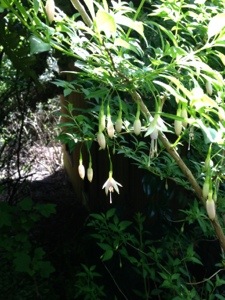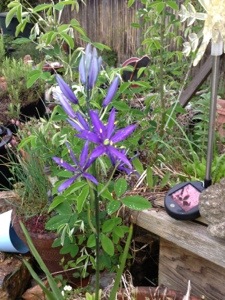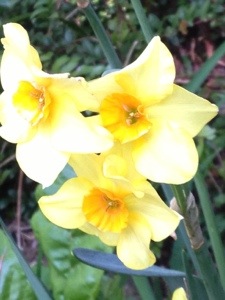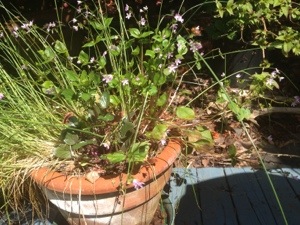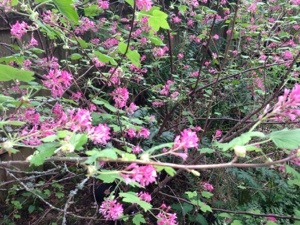
Ribes sanguineum, the red flowering currant, is (and I know I say this a lot, lol, but it’s really true!) one of my favorite natives. In this case, it’s not just because of the spectacular show of the bright white to pink to reddish pink flowers, it’s also because when this is in bloom, it is the queen of hummingbird plants. It blooms in early spring, sometimes even late winter, generally in March and April, about the same time as another hummingbird favorite, the salmonberry (Rubus spectabilis). Where salmonberry likes its feet wet, especially in winter, RFC likes it dry. It will take sun or shade, though is happiest somewhere between, and aside from not liking to be too wet is not picky about soils. I’ve seen beautiful ones growing in cracks in bedrock on steep cliffs, and others in the understory of closed canopy conifers. It’s a tough plant, and will take a fair amount of abuse and come back smiling. While I don’t recommend it, it’s one of the few shrubs you can literally plant and walk away, and as long as its not too dry, have a fair chance of getting it to survive. Regular watering the first few years will help immensely though.
As I said, it doesn’t like wet feet. If this plant has one major drawback, its that it seems to have weak roots. It is susceptible to root rot in various forms. Given too wet a spot, it may do well for a few year, but with any damage to the roots will quickly get root rot and more often than not, suddenly collapse. This also means that if its in the wrong spot, it rarely transplants well once established. You are actually better off taking cuttings and propagating the plant to where you want to move it to, than trying to transplant a bigger one. It is also one of the alternate hosts of a rust that also attacks white pines. This rust is rarely fat to the currant, but can quickly become so on the pine. If you have white pines, watch for yellow to orange rusty spots and speck long on the back of the leaves of the currant, and puss like weeping sap from canker like boils on the trunks of the pine. The cankers can kill the pine, but the currant generally simply sheds its leaves in fall, and is ok in spring, though the plant is often stressed enough if other factors affect the plant the combination can be lethal. Raking these leaves in fall is a must if you see them, dispose of them in a plastic bag, don’t burn them or put them in yard waste as the spores of the rust can then infect other plants. Other than that, these are generally easy care shrubs with few problems or diseases most of the time.
Pruning couldn’t be simpler. It responds well to pruning, even making it into a box like shrub hedge if needed. Just remember winter pruning will reduce flowers that year, though it will generally bounce back quickly from even a heavy pruning.
As you might expect, there are a fair number of cultivars of this amazingly ornamental shrub, both from local selections of wild or garden plants, and quite a few developed in Europe. When I first started planting natives, about the only one available in nurseries (and still one of the most common varieties) was “King Edward VII”. A friend and I joke that this is a species that had to “go to Europe to get an education” before people would accept it. Now there are dozens of cultivars, and as a testament to how much I love this plant, I have quite a few here myself.
Along with the straight native, I have ‘Strybing Pink’, ‘Pokey’s Pink’, ‘Appleblossom’, ‘Pulsborough Scarlet’, and ‘variegata’. I used to also have ‘Elk River Red’ which was very similar to Pulsborough Scarlet’, but is a more local selection, I think from Oregon.
I do these days try and stay away from California selections of the more southerly variety Ribes sanguineum glutinosum, simply because I would rather keep the species roots more intact. May be a silly thing, but I think it’s important.
I recently picked up another one, ‘White Icicle’, which I will try in the back. I like this cultivar, not just because the nearly pure white flowers are different than most I have, but because it tends to bloom a week or two earlier than the darker cultivars. This is one I believe was developed in BC, and is a tried and true cultivar, with a nice open slightly wider habit than some of the others.
The picture above is from the one seedling I have had self seed in the garden. Luckily it grew in a spot I can leave it, though its getting big enough I may have to start trimming it back. I refer to it myself as “Ace of Mercer”, but I don’t know if its special enough to warrant being a named cultivar. It is a nice medium dark pink, where most of the cultivars are selected for white, pale pink, or dark almost red flowers. This one is very much like the majority of the wildlings around. But then, many of the wild ones around here are every bit as dark as the “scarlet” and red cultivars.
I put scarlet in quotes because almost universally, these are really more pink than red. Even the darkest cultivars are more a a very dark saturated fuchsia pink red, than a slightly orange scarlet, if that makes sense. Some people who are sensitive to red don’t like calling these red because of that, and they do look better with more pink friendly colors than the orange side of the spectrum. I have seen a few wild ones turned more scarlet, but in most cases these look dry and kind of sickly, so I am not sure that is something you would want to emulate in your garden.
Whatever the color, these are excellent when in flower for attracting hummingbirds. These are so important for hummers, that more often than not, their flowering starts the season for catching a glimpse of the elusive Rufous in the garden. Most years the first rufous shows up about the same time these and the salmonberry start flowering. Almost like clockwork, around a week after the first flowers open I’ll start seeing a little reddish ball of fluff chasing the more resident Anna’s off their favorite shrub. It’s one of the reasons I have so many of these, lol. Even this year, when the currants started blooming about two weeks ahead of their normal bloom time, I saw the first rufous about five days later.
I think one of the reasons it is so important for this is that the shrub really does cover itself in flowers in full bloom. From overhead, as say for a migrating bird, it must shine like a great pink beacon! It really does draw in the birds amazingly well. The salmonberry may have showy individual flowers, but they don’t really catch your eye so much from across the garden. RFC is a by contrast a bright exclamation point in the garden.
Of course, it only flowers for a short period of time, little more than a month. Luckily the flowers are followed by odd little blue black berries. Though these are edible, they aren’t that great tasting to people. Chickadees and other fruit loving birds, on the other hand, seem to really enjoy them. I do tend to trim off fruits on plants just settling in, but fruit set on older plants can be pretty impressive in a good year. I’m actually surprised we don’t see more seedlings around.
Propagation is pretty easy, either from seed or from cuttings. I’m told seed is best from freshly picked fruits, cleaned and sewn directly, but I don’t have any direct experience with it. Cuttings can be taken near year round. Hard wood cuttings can be shoved directly into the soil where you want them to grow, in late summer and even winter, just be careful to water carefully in summer so the developing plants don’t dry out. The most successful way though is to do softwood cuttings, preferably with a mister of some kind, in a loose growing medium like pumice or pearlite. Most of the commercial propagation is done this way.
So Ribes sanguineum is an excellent wildlife plant, gorgeous ornamental, and all around stellar garden plant. For anyone who can grow it, especially on the west coast, you really should. The hummers will thank you!

